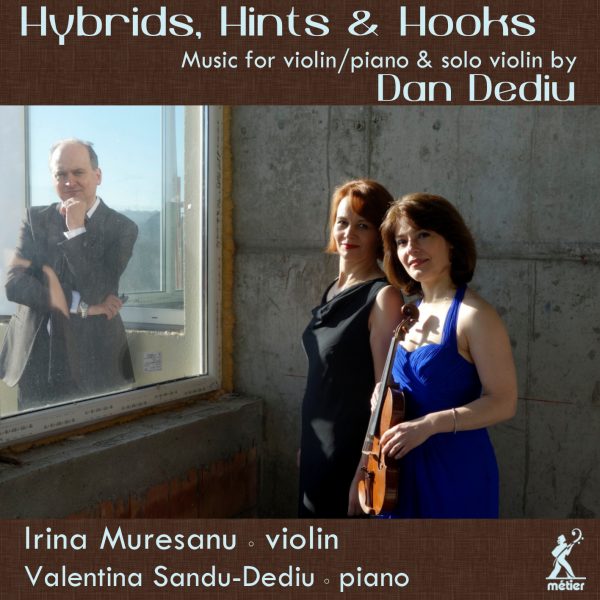Infodad
Some explorations of the past are spearheaded by composers rather than musical scholars or performers, and may be done quite overtly and for reasons of a composer’s own. That is the case with the music of Romanian composer Dan Dediu (born 1967) on a new Métier CD.
Dediu explicitly builds a major work around a combination of Strauss’ Don Juan and Mozart’s Don Giovanni, calling the result, which dates to 1995, a “SonatOpera.” In truth, the result is as awkward as the work’s title: filled with screechy high notes, harmonics and stop-and-start pacing, it goes on and on (for more than 20 minutes) without in any sense paying tribute to either earlier composer’s music or, indeed, making it clear what Dediu sees (or hears) in his source material. Written for Irina Muresanu and Valentina Sandu-Dediu, the piece is played by them with enthusiasm and a high level of involvement, but it is very difficult to imagine non-performing listeners becoming involved in the music to anything like the same extent – Dediu’s work will more likely send the audience back to Strauss and Mozart with a sigh of relief (or two).
A more-interesting work that was also composed for Muresanu and Sandu-Dediu is A Mythological Bestiary (2008), whose six movements are filled with the same repetitive and overdone techniques heard in the “SonatOpera” but whose elements are varied enough to encourage listeners to play an intellectual game of “how do those notes and instrumental combinations reflect that specific beast?” Thus, Griffin is piquant, Unicorn relaxed, Mandragora disconnected, Sphynx almost lithe, Hippogriffin oddly delicate (perhaps because its rear was that of a horse, while the griffin’s was that of a lion), and Dragon suitably slithery if not exactly fiery.
The two extended violin-and-piano works on this disc are complemented by two pieces for violin solo. The two-movement sonata of 1987 has a thinness and bite that makes an interesting contrast with the works of Ysaÿe and other composers of earlier in the 20th century: the second movement, Andante rubato, is another place where Dediu shows his fondness for stop-and-start pacing rather than anything approaching lyricism. As for looking back toward earlier composers, Dediu does so quite explicitly not only in the “SonatOpera” but also in À la recherche de la Marseillaise de Stravinsky (2008), which is impressive in its technical demands – all of which Muresanu handles without apparent difficulty – but which includes none of the rhythmic, harmonic or evocative creativity that makes so much of Stravinsky’s music attractive. Dediu’s works on this CD are limited in their appeal, being well-constructed and performed with a high level of skill, but lacking most of the particular attractions on which earlier composers, including the ones whose pieces are of interest to Dediu, relied on to much better effect.
@divineartrecordingsgroup
A First Inversion Company
Registered Office:
176-178 Pontefract Road, Cudworth, Barnsley S72 8BE
+44 1226 596703
Fort Worth, TX 76110
+1.682.233.4978












![Listen to the full suite of Marcel Dupré’s Variations Sur un Noël, Op. 20 from Alexander Ffinch’s #Expectations release today! listn.fm/expectations [in bio]](https://scontent-dfw5-1.cdninstagram.com/v/t51.71878-15/588904367_2327488161082898_8709236950834211856_n.jpg?stp=dst-jpg_e35_tt6&_nc_cat=105&ccb=7-5&_nc_sid=18de74&efg=eyJlZmdfdGFnIjoiQ0xJUFMuYmVzdF9pbWFnZV91cmxnZW4uQzMifQ%3D%3D&_nc_ohc=BGoHgV_YYfIQ7kNvwHw-krK&_nc_oc=AdnhCz2XLzNs_0K5c-205in3YNZ_Eng2zrdmv-D0d6UfUlspJmpoCM_4EkDmYSAG6xb-vWOtLJ1TxGy-TWhzRcU-&_nc_zt=23&_nc_ht=scontent-dfw5-1.cdninstagram.com&edm=ANo9K5cEAAAA&_nc_gid=pzWwr47mCFqWDqRMk6KcYg&oh=00_AfrkNCcH_ijU5wWXns3JWtms9i4vjFBLwPwG_8RvBm0ZhQ&oe=695E332A)